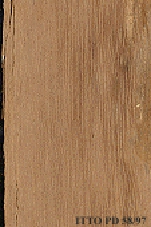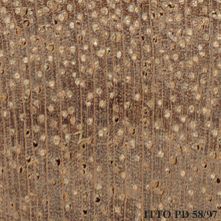
URUCURANA (Hyeronima chocoensis)
Trade Name
Urucurana
Scientific Name
Hyeronima chocoensis Cuatrec.
Family
EUPHORBIACEAE
Common Names
Urucurana (Brazil)
Description Of The Tree
Botanical Description
The trees are reported to reach heights of 30 m or more, with trunk diameters over the buttresses of 100 cm. They develop well-formed and cylindrical boles that are up to 12 m long or more.
Natural Distribution
This species occurs in northern South America. It is reported in Brazil, Venezuela, Colombia and Ecuador.
Wood Identification
Anatomic Description Of Wood
Vessels exclusively solitary (over 90%). Occasionally vascular/vasicentric tracheides present. Occasionally multiple perforation plates. Vessel-ray pits larger than the intervessel pits. Apotracheal axial parenchyma diffuse and/or diffuse in aggregates. Occasionally prismatic crystals in non-chambered axial parenchyma cells. Rays of two distinct sizes. Prismatic crystals in the ray cells. Heterogeneous rays and/or multiseriate heterogeneous rays. Fibers with distinctly bordered pits.
-
 Wood Macro Photo Tangential Plane
Wood Macro Photo Tangential Plane
-
 Wood Micro Photo Of Transversal Section
Wood Micro Photo Of Transversal Section
Availability
Cites Status
Unrestricted
General Wood Description
Odor
Odor is absent when dry, but it has a typical unpleasant smell when freshly cut.
Color
The sapwood is yellowish pink, the heartwood is dark brown.
COLOR INDEX (1=Black, 7=Light yellow,white)
4
Grain
Interlocked grain is reported in this species.
Texture
Medium texture is reported in this species.
Luster
It has a low to moderate luster.
Natural durability index (1= Very high durability, 7=Vey low durability)
4
Wood Physical Properties
Basic Density or Specific Gravity (O.D. weight/vol. green) (g/cm³)
0.71
Air-dry Density (Weight and volume at 12%MC) (g/cm³)
0.80
Total shrinkage Tangential (Saturated to 0%MC) (%)
11.1
Total shrinkage Radial (Saturated to 0%MC) (%)
5.7
Drying Defects
Ease of Drying: It is reported to air season rapidly. Drying Defects: Slight warping and checking.
Recommended Dry Kiln Schedule
JUNAC-B
Dimensional stability ratio (Total Tangential Shrinkage %/Total Radial Shrinkage %)
1.9
Wood Chemical Properties
Wood Mechanical Properties
Bending Strength (MOR),12%MC (kgf/cm²)
1019
Stiffness (MOE) 12%MC (kgf/cm²)
158964
Compression parallel to fiber 12%MC (kgf/cm²)
673
Workability
Sawing
Sawing of this species is reported to be rather difficult.
Rotary Veneer Cutting
This timber is reported to be suitable for lamination.
Sliced Veneer
This timber is reported to be suitable for lamination.
Planing
Planing operations are difficult if highly interlocked grain is present.
Turning
30
Finishing
Finishing of this species is reportedly easy.
REFERENCED USES
End Uses Summary
HOUSING GENERAL, beams, flooring, parquet, steps, FURNITURE AND CABINETS, cabinets, PLYWOOD AND VENEER, TURNING
General Housing
- 10 - Silica in Timbers
Beams
- 11 - Prospect: The wood database
Flooring
- 14 - Handbook of Hardwoods
Parquet
- 15 - Empire Timbers
Steps
- 17 - Tree Conservation Database
Furniture Cabinets
- 21 - Tropical timbers of the world. Part III-Southeast Asian and Oceanian Species.
Cabinet
- 24 - Empire Timbers
Panels, Veneers
- 25 - Directory of Timber Trade Malaysia
Turning
- 30 - Embassy of Honduras in Japan
Please Provide Information To View Producer Information